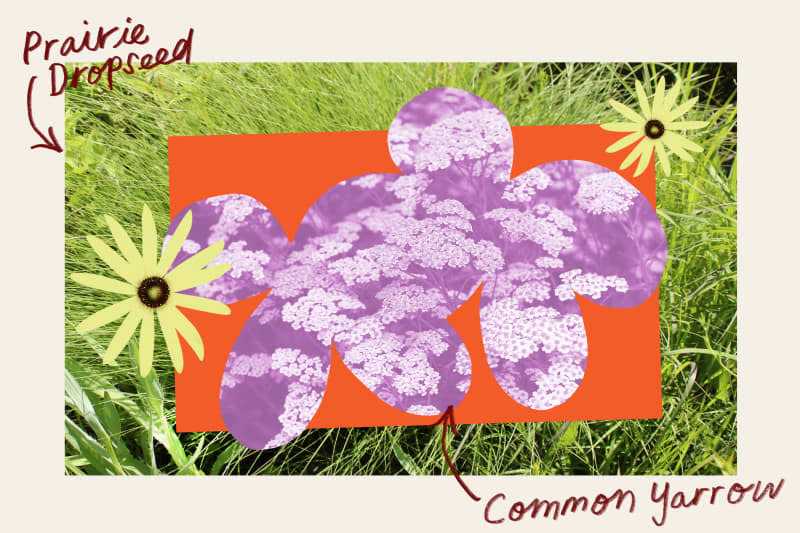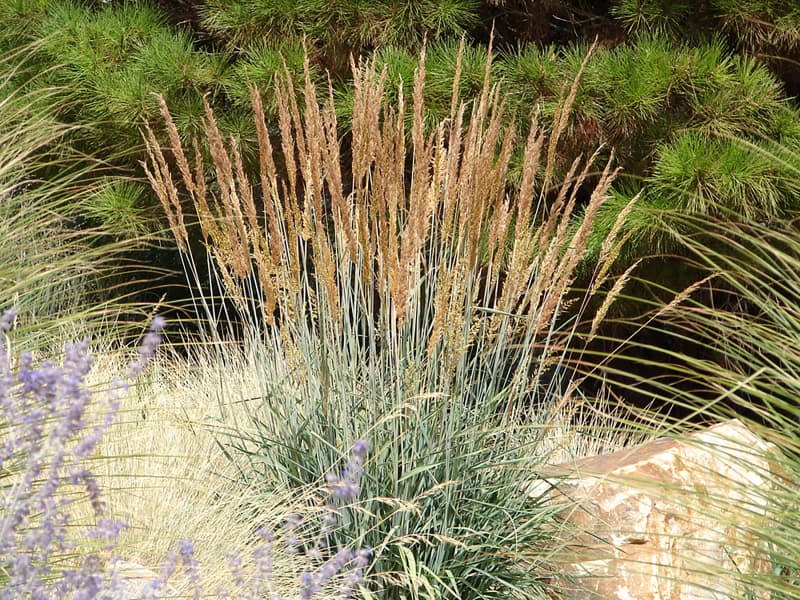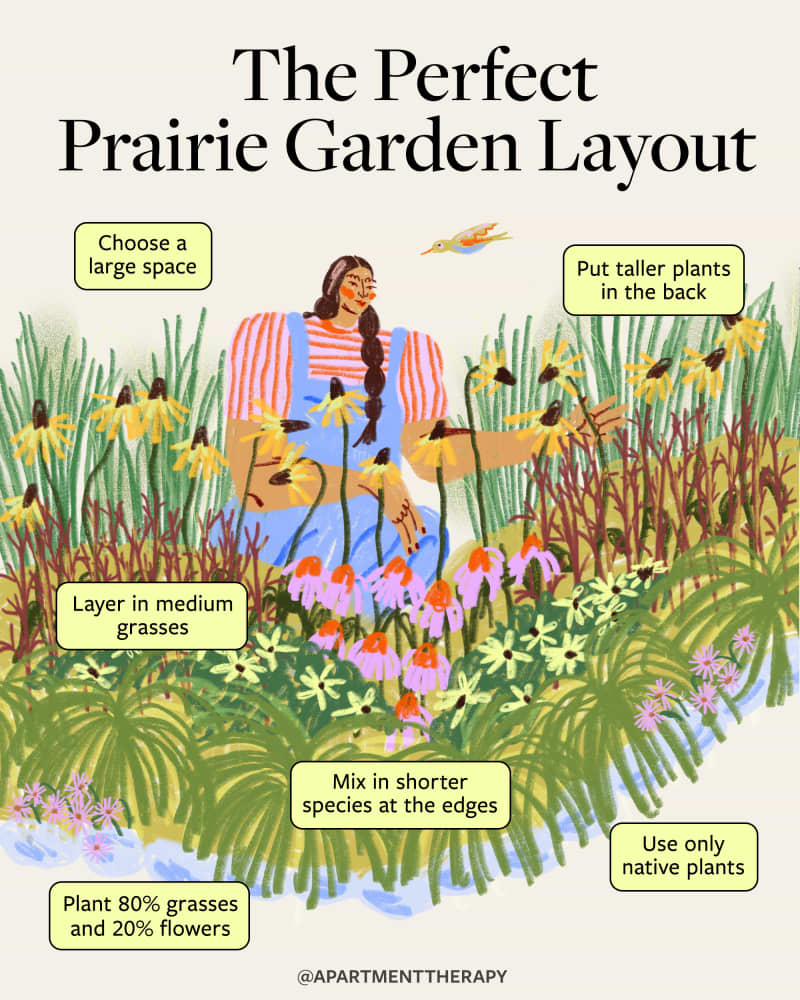The No-Maintenance Yard Hack to Never Water Your Lawn Again

Turn your outdoor space into a summer oasis with decorating hacks, no-fail lawn and garden tips, and more with Yard Therapy. This content is presented by The Home Depot; it was created independently by our editorial team.
Traditional lawns require a lot of care, including regular watering, mowing, and fertilizer applications. However, if you’re in search of something more low-maintenance, sustainable gardening practices are your friend. Clover lawns and wildflower lawns have been favored choices for a while now, but another turfgrass alternative that’s gaining traction among homeowners is the prairie garden.
A prairie lawn is a lawn or garden filled with native grasses and wildflowers that mimic a natural prairie habitat. Prairies are flat, fertile lands primarily composed of wild, native grasses with a few hardy wildflowers; they’re filled with drought-tolerant warm-season species. According to the National Park Service, prairies once covered almost one-third of North America, making prairie lawns a great option for turfgrass lawn alternatives in natural prairie environments like The Great Plains in the United States and Canada and the U.S. Midwest.
Benefits of Prairie Lawns
According to experts I spoke with, adding a prairie lawn to your landscape has many benefits. Prairies provide habitat and act as a food source for native wildlife in the area, such as pollinators, birds, insects, and more.
Prairie gardens and lawns are also low-maintenance once they are established, requiring very little (if any) upkeep. According to the Illinois Department of Natural Resources, after a year or two, you never need to water your prairie lawn.
According to the Minnesota Department of Natural Resources, prairie lawns also provide plenty of ecological benefits to the soil and surrounding landscape such as improving soil quality, filtering pollutants from the air and water, and preventing soil erosion and flooding.

How to Start a Prairie Lawn
Are you ready to cut down on watering and plant a prairie lawn or garden in your yard? Here’s what you need to know about starting your own prairie lawn.
Start planting in the fall or early spring.
Planting your prairie lawn in the fall or early spring will give the plants and seeds the best chance of survival, says Ward Dilmore, co-founder of Petrus Landscaping based out of California. If you start in the fall, ensure that you have your plants in the ground three to four weeks before the first frost so they can begin to establish before the cold weather hits. Similarly, if you are starting in the spring, aim to get plants and seeds in the ground after the threat of intense frost has passed, but before the hot summer weather hits.
Choose the right space.
Prairie lawns and gardens are suitable for dry, full-sun sites so you should choose a location that receives at least six to eight hours of direct sunlight daily, says Mary Phillips, head of native plant habitat strategy/certifications at the National Wildlife Federation. Avoid cool, moist locations, which are better suited to grass alternatives like clover lawns or meadow gardens.
Use a mix of the right plants.
Undoubtedly the most important part of creating a prairie lawn is choosing the best plants to grow for your region. Prairies are composed of a mix of native grasses and flowers, so you should always use native species to fill your prairie lawn. As a general rule of thumb, Phillips recommends using the 80/20 rule for grasses and flowers: 80% native grasses and 20% native wildflowers.
Give your prairie garden time to establish.
Once established, prairie lawns require little to no maintenance. However, a new prairie lawn will need a little bit of love to help it get started. Ensure you water the area consistently until the plants are rooted, at which point you can cut back on manual watering and let Mother Nature do her thing.
Also, keep an eye out for weeds (invasive and non-native species) and remove them as needed. A mature prairie lawn will be able to combat weeds effectively on its own, but until those strong roots are established it may be vulnerable to aggressive weeds determined to take over the space.

Best Plants for Prairie Lawns
Because native plants are critical for creating a successful and sustainable prairie lawn, every prairie lawn will look a little different depending on the region. That said, there are a few common species that are staples in many prairie lawns, thanks to their adaptability and wide geographical range. There are also grasses and flowers that work better in some regions than others, so you can look up what’s native to your location, and add them in addition to the general prairie lawn grasses and flowers. For instance, Colorado’s state grass is blue grama (Bouteloua gracili).
Common Prairie Lawn Grasses
Big bluestem (Andropogon gerardi)
Little bluestem (Schizachyrium scoparium)
Indiangrass (Sorghastrum nutans)
Sideoats grama (Bouteloua curtipendula)
Panicgrass (Panicum rigidulum)
Switchgrass (Panicum virgatum)
Prairie dropseed (Sporobolus heterolepis)
Common Prairie Lawn Flowers
Black-eyed susan (Rudbeckia hirta)
Pale purple coneflower (Echinacea pallida)
Blazing star (Liatris spp.)
Goldenrod (Solidago spp.)
Common milkweed (Asclepias syriaca)
Asters (Aster spp.)
Blanket flower (Gaillardia spp.)
Common yarrow (Achillea millefolium)
If you’re not in a typical prairie region, you may still be able to plant a prairie garden. To ensure success, check with your local parks and natural resource departments’ websites to see what the best plants for your region are.

The Best Layout for a Prairie Lawn
One of the best parts of a prairie lawn or garden is that you can get creative with the layout, but the experts share a few tips to help you nail the look and practicality of a prairie lawn in your space.
Choose a large space.
Go big or go home! If possible, Phillips recommends mapping out a large area for your prairie lawn. “Aim for at least 30 to 50 square feet for a basic prairie garden,” she says. This will encourage greater plant diversity and reduce the amount of traditional turfgrass in the area — a win-win!
Layer plants by height to create interest.
The layout of your prairie lawn or garden doesn’t have to be totally random. While naturally occurring prairies have grasses and flowers growing wild, you can craft an aesthetic prairie lawn that is still just as environmentally beneficial with a little bit of planning.
“Taller species like panicgrass (Panicum sp.) and giant coneflower (Rudbeckia maxima) should be placed in the back of the garden or interspersed with medium-size species like big bluestem (Andropogon), false indigo (Baptisia), black-eyed susan (Rudbeckia hirta), and coneflower (Echinacea), surrounded by a mix of shorter species at the edges like little bluestem (Schizachyrium scoparium), prairie dropseed (Sporobolus heterolepis), and North American asters (Symphyotrichum),” says Jordan Clough, associate principal at Richardson & Associates Landscape Architecture in Washington, D.C.
Take seasonality into consideration.
Clough also recommends being prepared for how your prairie lawn will change aesthetically throughout the seasons. Prairie grasses and flowers are at their peak in the mid-late summer and into the fall so the garden might not look like much before this time. “This is an aesthetic adjustment from what we typically envision as a ‘well-maintained’ garden,” he says. Take this into account as you plan the layout of your landscape.
Choose a location away from flammable structures.
Lastly, because prairies are naturally dry areas filled with grasses, out of an abundance of caution Phillips recommends choosing a location that isn’t directly up against the side of your house or any other flammable structure on your property. This is especially true if wildfires are common in your area. Your local fire department may have more specific guidelines based on your region, so be sure to do your research before you get planting.

